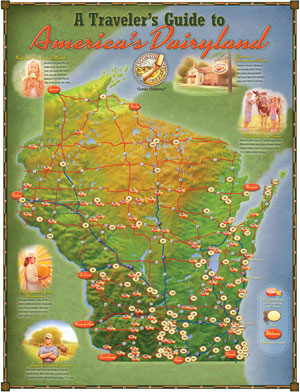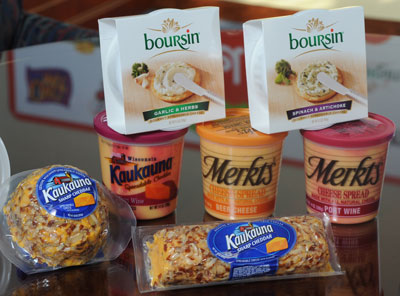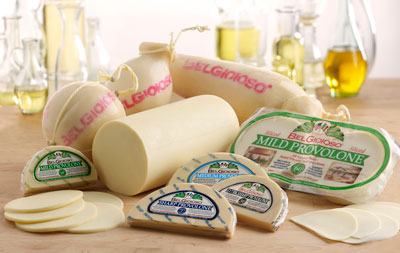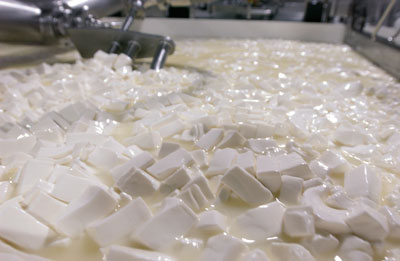Cheese companies stand the test, taste of time
Just like cheese, its makers come in all types and sizes. Three of the area’s well-known makers have gotten to where they are today based on their roots and early beginnings as smaller businesses that have evolved, some might say, from contributing to a slice of the industry to taking up more of the wheel.
“We’re unique in that we’re cold packed cheeses,” says Ed Blascak, director of operations for Bel Brands USA in Little Chute. Bel Brands, based in Chicago, works primarily with cheddar-based and some sour cream-based snacking, gourmet and cold pack cheeses. Bel Brands is a U.S. subsidiary of Fromageries Bel based in Paris.
The company is the largest producer of cold pack cheeses in the country and the only spreadable cheese producer in the state. The business purchases cheese from seven different cheese companies to create their products. Consumers can find them under eight different labels — Owl’s Nest, The Laughing Cow, Kaukauna, Mini Babybel, Merkts, Boursin, Price’s, and WisPride.
“The flavors are nice and sharp. The cold pack doesn’t denigrate the flavor within the cheese,” Blascak says.
BelGioioso in Green Bay makes close to 30 varieties of Italian cheese with mozzarella, provolone and parmesan holding the top three positions, respectively. They produce and market the cheese they sell, along with some private label cheeses, but 90 percent is under the BelGioioso brand.
According to President Errico Auricchio, milk is collected from almost 200 farms daily and it takes 10 pounds of milk to create 1 pound of cheese.
“The fresher the milk, the better the cheese,” he explains. “We do the best we can, our emphasis is on quality, quality, quality. … The main focus is and will remain the Italian cheeses.”
The base creation of the cheese remains the same without many changes since the company started, says Auricchio who built upon the tradition of his great-grandfather from a century ago when he moved his family from Italy to America in 1979 and started BelGioioso.
Simon’s Specialty Cheese in Appleton celebrated its 75th anniversary in August and has been making the same cheeses, with the exception of feta added in the mid-1980s, since its inception. That includes cheddar, provolone, mozzarella and cheese curds. The Appleton-based business joined the Agropur umbrella in 2008, but started with Art and Ann Simon when cheese was sold from the Little Chute plant until 1972 when the first retail location opened. A larger store was built adjacent to the plant in December 1984 and another was later built at its current location in November 2000. A trio of cheesemaking families came together in 2003 to form Trega Foods, which was acquired by Agropur in 2008.
Today, milk from more than 300 local dairy farms goes into making Simon’s cheese.
“Today’s farms are getting more and more sophisticated,” says Mike Sipple, vice president Technical Services with Agropur. “They’ve just gotten bigger as we’ve gotten bigger. If milk doesn’t meet standards, it’s not accepted.”
Simon’s cheese curds remain a popular product with customers, says David Sohrweide, general manager of Simon’s Specialty Cheese Store. Cheddar and mozzarella, if you include pizzas, are the two top products for Simon’s.
Auricchio recalls the days when buyers wanted cheese in bulk, but now purchase wedges, grated, shredded, shaved and cubed cheese. The longer a cheese is aged, the easier it is to grate, shares Auricchio. BelGioioso ages their cheese up to 18 months depending on the cheese in a moisture- and temperature-controlled environment. The American Grana, an extra-aged parmesan with a deep nutty flavor, is the longest aged BelGioioso cheese.
“The aging is like babysitting, you have to watch the baby,” Auricchio says.
“That’s an art, when you have someone who has enough experience who can smell the cheese and say, ‘This is right,’” adds Blascak.
Blascak says that Bel Brands starts at the beginning of the supply chain through to the consumer and challenges what’s working and what may need tweaking with the products they produce, including reducing additives while maintaining the core product which dates back 98 years to Kaukauna Klub, a cheese developed by a beer distributor who supplied the beverage to area supper clubs.
Blascak feels there is room for all cheesemakers and it really comes down to the times and places consumers use cheese — cooking, entertaining, picnics, etc. Each type of cheesemaker offers the market a different niche and philosophy, he says.
“Cheese is loaded with protein. It’s a really good food nutritionally. There’s opportunity for cheeses and cheesemakers of all kinds and we’re really excited about that,” says Sipple.
Currently, beer and spicy cheeses are on trend. BelGioioso also makes a cheese with a hot pepper inside and Simon’s “plays with vats of that every now and then,” along with tomato basil, adds Julie Poburka, assistant store manager.
“Innovation is great, but we want to maintain the roots, the integrity,” Auricchio says of BelGioioso. “Many trends are just fades. When you’re making different cheeses, it’s like making different sauces.”

Click image to download the Wisconsin Milk Marketing Board’s A Traveler’s Guide to America’s Dairyland
At the store, Poburka and Sohrweide are looking for ways to recognize cheese itself as an everyday food versus an occasional offering, expand customer palettes and broaden the way people use cheese. Sohrweide refers to it as an “experiential opportunity.” He stresses the importance of the “community connection” Simon’s has built over the years.
Each of the companies also participate in state and national cheese competitions and use the results to better their products.
“It’s a place where there’s a technical measure of your cheese,” says Sipple. “It helps keep us great. … At the end of the day, it’s the customer that rules.”
“Competition is a marketing tool. It doesn’t sell a lot of cheese,” Auricchio shares. “Our goal is to find loyal customers.”
At the end of the day, what matters most to these cheesemakers is satisfying their customers with a quality product.
“That is such an unbelievable feeling,” says Blascak. “To walk into a store, not only in Wisconsin, and to see your product and see people buying your product it is a great feeling.”
“They could go to other places and don’t, they choose to come back here,” Sohrweide adds.
—FC













Leave a Comment